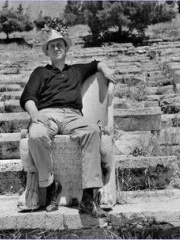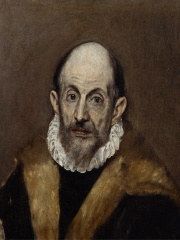
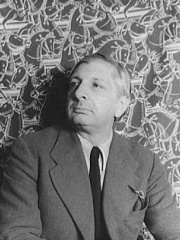
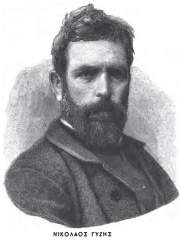
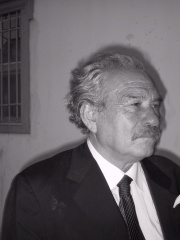
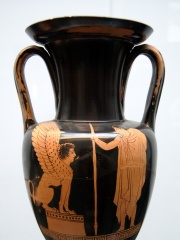


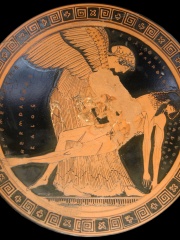
The Most Famous
PAINTERS from Greece
Top 10
The following people are considered by Pantheon to be the top 10 most legendary Greek Painters of all time. This list of famous Greek Painters is sorted by HPI (Historical Popularity Index), a metric that aggregates information on a biography's online popularity. Visit the rankings page to view the entire list of Greek Painters.

1. El Greco (1541 - 1614)
With an HPI of 84.26, El Greco is the most famous Greek Painter. His biography has been translated into 105 different languages on wikipedia.
Doménikos Theotokópoulos (Greek: Δομήνικος Θεοτοκόπουλος, pronounced [ðoˈminikos θeotoˈkopulos]; 1 October 1541 – 7 April 1614), most widely known as El Greco (Spanish pronunciation: [el ˈɣɾeko]; "The Greek"), was a Greek painter, sculptor and architect of the Spanish Renaissance, regarded as one of the greatest artists of all time. El Greco was a nickname, and the artist normally signed his paintings with his full birth name in Greek letters often adding the word Κρής (Krḗs), which means "Cretan" in Ancient Greek. El Greco was born in the Kingdom of Candia (modern Crete), which was at that time part of the Republic of Venice, and the center of Post-Byzantine art. He trained and became a master within that tradition before traveling at age 26 to Venice, as other Greek artists had done. In 1570, he moved to Rome, where he opened a workshop and executed a series of works. During his stay in Italy, El Greco enriched his style with elements of Mannerism and of the Venetian Renaissance taken from a number of great artists of the time, notably Tintoretto and Titian. In 1577, he moved to Toledo, Spain, where he lived and worked until his death. In Toledo, El Greco received several major commissions and produced his best-known paintings, such as View of Toledo and Opening of the Fifth Seal. El Greco's dramatic and expressionistic style was met with puzzlement by his contemporaries but found appreciation by the 20th century. El Greco is regarded as a precursor of both Expressionism and Cubism, while his personality and works were a source of inspiration for poets and writers such as Rainer Maria Rilke and Nikos Kazantzakis. El Greco has been characterized by modern scholars as an artist so individual that he belongs to no conventional school. He is best known for tortuously elongated figures and often fantastic or phantasmagorical pigmentation, marrying Byzantine traditions with those of Western painting.

2. Giorgio de Chirico (1888 - 1978)
With an HPI of 75.23, Giorgio de Chirico is the 2nd most famous Greek Painter. His biography has been translated into 58 different languages.
Giuseppe Maria Alberto Giorgio de Chirico ( KIRR-ik-oh; Italian: [ˈdʒordʒo de ˈkiːriko]; 10 July 1888 – 20 November 1978) was an Italian artist and writer born in Greece. In the years before World War I, he founded the scuola metafisica art movement, which profoundly influenced the surrealists. His best-known works often feature Roman arcades, long shadows, mannequins, trains, and illogical perspective. His imagery reflects his affinity for the philosophy of Arthur Schopenhauer and of Friedrich Nietzsche, and for the mythology of his birthplace. After 1919, de Chirico became a critic of modern art, studied traditional painting techniques, and later worked in a neoclassical or neo-Baroque style, while frequently revisiting the metaphysical themes of his earlier work. In 2018, it was suggested that de Chirico may have suffered from Alice in Wonderland syndrome.

3. Nikolaos Gyzis (1842 - 1901)
With an HPI of 64.95, Nikolaos Gyzis is the 3rd most famous Greek Painter. His biography has been translated into 31 different languages.
Nikolaos Gyzis (Greek: Νικόλαος Γύζης [niˈko.la.os ˈʝi.zis]; German: Nikolaus Gysis; 1 March 1842 – 4 January 1901) is considered one of Greece's most important 19th century painters. He was most famous for his work Eros and the Painter, his first genre painting. It was auctioned in May 2006 at Bonhams in London, being last exhibited in Greece in 1928. He was the major representative of the Munich School, the major 19th-century Greek art movement.

4. Jannis Kounellis (1936 - 2017)
With an HPI of 64.32, Jannis Kounellis is the 4th most famous Greek Painter. His biography has been translated into 25 different languages.
Jannis Kounellis (Greek: Γιάννης Κουνέλλης; 23 March 1936 – 16 February 2017) was a Greek Italian artist based in Rome. A key figure associated with Arte Povera, he studied at the Accademia di Belle Arti in Rome.

5. Agatharchus (500 BC - 460 BC)
With an HPI of 63.15, Agatharchus is the 5th most famous Greek Painter. His biography has been translated into 23 different languages.
Agatharchus or Agatharch (Ancient Greek: Ἀγάθαρχος) was a self-taught painter from Samos, who lived in the 5th century BC. His father was named Eudemos (Εὔδημος). He is said by Vitruvius to have invented scenic painting, and to have painted a scene (scenam fecit) for a tragedy which Aeschylus exhibited. Hence some writers, such as Karl Woermann, have supposed that he introduced perspective and illusionism into painting. However, as this appears to contradict Aristotle's assertion that scenic painting was introduced by Sophocles, some scholars understand Vitruvius to mean merely that Agatharchus constructed a stage. But the context shows clearly that perspective painting must be meant, for Vitruvius goes on to say that Democritus and Anaxagoras, carrying out the principles laid down in a treatise written by Agatharchus, wrote on the same subject, showing how, in drawing, the lines ought to be made to correspond, according to a natural proportion, to the figure which would be traced out on an imaginary intervening plane by a pencil of rays proceeding from the eye, as a fixed point of sight, to the several points of the object viewed. It was probably not till towards the end of Aeschylus's career that scenic painting was introduced, and not till the time of Sophocles that it was generally made use of, which may account for what Aristotle says. Agatharchus was therefore the first painter known to have used graphical perspective on a large scale, although rare occurrences of perspective do appear in vase painting around the middle of the 6th century BC. He is also said to have led the way for later painters, such as Apollodorus. Agatharchus was a contemporary of Alcibiades and Zeuxis, and was often singled out for the ease and rapidity with which he finished his works. Plutarch and Andocides at greater length tell an anecdote of Alcibiades having inveigled Agatharchus to his house and kept him there for more than three months in strict durance, compelling him to paint it. The speech of Andocides above referred to seems to have been delivered after the destruction of Melos (416 BC) and before the expedition to Sicily (415 BC); so that from the above data the age of Agatharchus may be accurately fixed.

6. Achilles Painter (470 BC - 425 BC)
With an HPI of 61.86, Achilles Painter is the 6th most famous Greek Painter. His biography has been translated into 21 different languages.
The Achilles Painter was a vase-painter active ca. 470–425 BC. His name vase is an amphora, Vatican 16571, in the Vatican Museums depicting Achilles and dated 450–445 BC. An armed and armored Achilles gazes pensively to the right with one hand on his hip. The other hand holds a spear. On the opposite surface a woman performs libation. J. D. Beazley attributed over 200 vases to his hand, the largest share being red-figure and white-ground lekythoi. In his middle phase (ca. 450–445 BC), he decorates more open forms. The Achilles Painter was a late pupil of the Berlin Painter. The Phiale Painter became the Achilles Painter's most prominent student after he assumed the Berlin Painter's workshop. Almost a dozen other recognizable painters passed through the Achilles Painter's workshop as well. Notable painters include the Westreenen Painter, the Persephone Painter, the Clio Painter, Loeb Painter, and the Dwarf Painter. The Kleophon Painter, the Sabouroff Painter, and the Painter of Munich 2335 all spent time at the workshop as well.

7. Timarete (420 BC - 400 BC)
With an HPI of 60.98, Timarete is the 7th most famous Greek Painter. Her biography has been translated into 17 different languages.
Timarete (Greek: Τιμαρέτη) (or Thamyris, Tamaris, Thamar; 5th century BC), was an ancient Greek painter. She was the daughter of the painter Micon the Younger of Athens. According to Pliny the Elder, she "scorned the duties of women and practised her father's art." At the time of Archelaus I of Macedon she was best known for a panel painting of the goddess Diana that was kept at Ephesus, a city that the goddess. While it is no longer extant, it was kept at Ephesus for many years. She is one of the six female artists of antiquity mentioned in Pliny the Elder's Natural History (XL.147–148) in A.D. 77: Timarete, Irene, Calypso, Aristarete, Iaia, Olympias.

8. Apollodorus (500 BC - 460 BC)
With an HPI of 60.97, Apollodorus is the 8th most famous Greek Painter. His biography has been translated into 22 different languages.
Apollodorus Skiagraphos (Greek: Ἀπολλόδωρος ὁ σκιαγράφος) was an influential Ancient Greek painter of the 5th century BC whose work has since been entirely lost. Apollodorus left a technique behind known as skiagraphia, a way to easily produce shadow, that affected the works not only of his contemporaries but also of later generations. This shading technique uses hatched areas to give the illusion of both shadow and volume.

9. Douris (600 BC - 500 BC)
With an HPI of 60.09, Douris is the 9th most famous Greek Painter. His biography has been translated into 15 different languages.
Douris or Duris (Ancient Greek: Δοῦρις, Douris) was an ancient Athenian red-figure vase-painter and potter active c. 500 to 460 BCE.
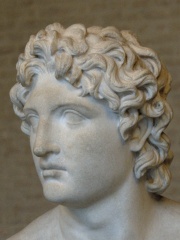
10. Euphranor (301 BC - 400 BC)
With an HPI of 59.54, Euphranor is the 10th most famous Greek Painter. His biography has been translated into 17 different languages.
Euphranor of Corinth (Ancient Greek: Εὐφράνωρ) (middle of the 4th century BC) was a Greek artist who excelled both as a sculptor and as a painter. Pliny the Elder provides a list of his works including a cavalry battle, a Theseus, and the feigned madness of Odysseus among the paintings; and Paris, Leto with her children Apollo and Artemis, and Philip and Alexander in chariots among the statues. No known existing statues have been identified as copies from works of Euphranor (but see a series of attributions by Six in Jahrbuch, 1909, 7 foil.). His work appears to have resembled that of his contemporary Lysippus, notably in the attention he paid to symmetry, in his preference for bodily forms slighter than those usual in earlier art, and in his love of heroic subjects. He wrote a (now lost) treatise on proportions. He was a contemporary of Antorides, and, like him, studied under Ariston.
People
Pantheon has 14 people classified as Greek painters born between 600 BC and 1936. Of these 14, none of them are still alive today. The most famous deceased Greek painters include El Greco, Giorgio de Chirico, and Nikolaos Gyzis.
Deceased Greek Painters
Go to all RankingsEl Greco
1541 - 1614
HPI: 84.26
Giorgio de Chirico
1888 - 1978
HPI: 75.23
Nikolaos Gyzis
1842 - 1901
HPI: 64.95
Jannis Kounellis
1936 - 2017
HPI: 64.32
Agatharchus
500 BC - 460 BC
HPI: 63.15
Achilles Painter
470 BC - 425 BC
HPI: 61.86
Timarete
420 BC - 400 BC
HPI: 60.98
Apollodorus
500 BC - 460 BC
HPI: 60.97
Douris
600 BC - 500 BC
HPI: 60.09
Euphranor
301 BC - 400 BC
HPI: 59.54
Pamphilus
390 BC - 400 BC
HPI: 59.50
Yannis Tsarouchis
1910 - 1989
HPI: 55.69
Overlapping Lives
Which Painters were alive at the same time? This visualization shows the lifespans of the 6 most globally memorable Painters since 1700.


